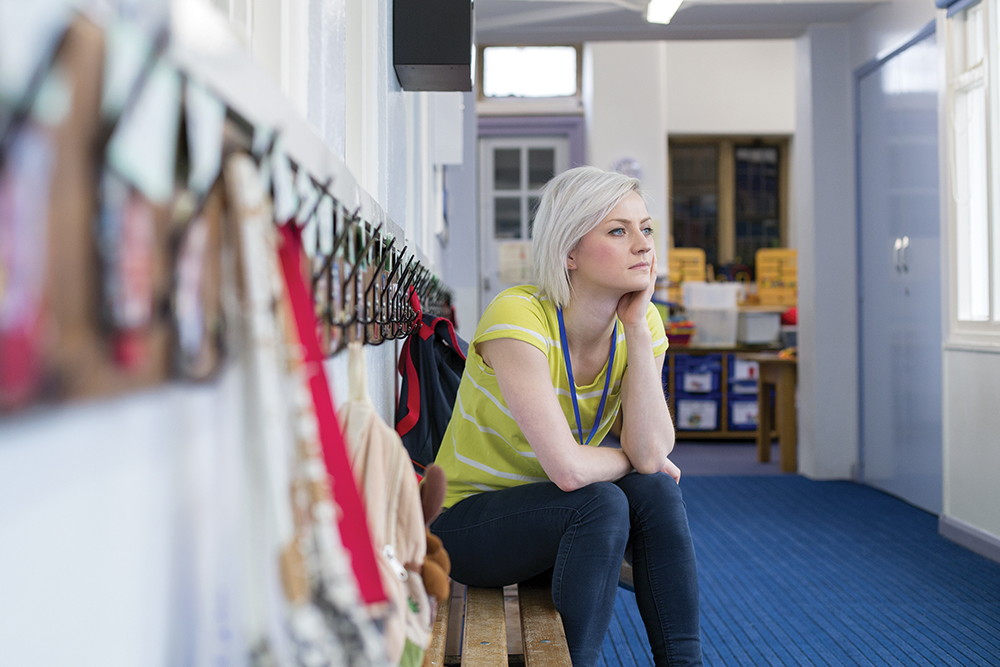Ask any experienced or veteran teacher for advice and one thing you will always hear is “never take work home with you.” But what nobody really says is that avoiding “taking work home with you” also means trying not to carry the weight of secondary trauma, PTSD, anxiety, insomnia, and constantly changing policies, all of which are proven to affect teachers at high rates. Sure, teachers can stay at school after hours to finish grading papers or complete lesson plans for the week, but part of being a teacher, especially during the Covid-19 pandemic, also means taking extra time and effort to show ourselves grace, focus on our mental health, and practice self-care.
During the third week of school, I told my writing class that they would have homework to make up for the work we could not get to in class. Maybe I made the wrong move.
“Ms. Insong, please don’t give me any more homework,” a student said to me while in tears. “There is no one to help me with my homework at home. My big sister isn’t here anymore.”
“What do you mean?” I responded.
“She got Covid and passed away in May. She was the only one who could help me with my homework. Now I don’t have anyone to help me with my homework.”
She continued to cry. My eyes began to water. After my class left to transition, I stepped out of class to unload the bricks that weighed on my chest. I cried, too.
Family members are in the hospital. Loved ones have suddenly passed away. Parents have lost their jobs. People are struggling to make ends meet during this strangely uncertain time. We are forced to accept and adjust to today’s reality. Students and teachers are afraid of more than just the virus. We are also afraid of the effects it can have on our futures. For students, a loss of a parent or guardian can lead to other challenges such as loss of household income and homelessness — just to name a few. If students don’t show up to school, teachers could possibly lose their jobs. Students are trying to stay focused while coping with issues beyond the classroom, and teachers are trying their best to do the same while finding ways to help students regulate their emotions and make up for the time lost in the classroom.
Hearing the reality firsthand, especially from children, can take a toll on school workers. I found that taking care of my mental health and practicing self-care is essential to staying healthy and present in the classroom. In the media, self-care is often painted as having a glass of wine after a long day at work or taking yourself out to dinner — and although these are all enjoyable pleasures, getting wine drunk for the night won’t solve all your problems. Self-care is a daily practice that encompasses much more than that. Just like therapy, it won’t work unless you stay committed and you do the work. According to the National Institute of Mental Illness (NAMI), there are six elements of self-care: physical, psychological, emotional, spiritual, social, and professional. It is recommended that people spend at least two to three hours a day practicing self-care. One of the biggest and most effective acts of self-care is saying “no” and maintaining healthy boundaries.
Setting boundaries in the professional setting can look like saying no to extra tasks when you know you already have a lot on your plate. Even as a professional, working hard to reach deadlines and objectives, it’s important to remember that it is okay to pause and breathe. Step out of the classroom for a few minutes when you are overwhelmed. Remember that whatever energy you bring into the classroom, your students will feel, too (and vice versa).
With the mental and emotional effects of Covid-19 in mind, some schools in Memphis have taken action to make social-emotional learning (SEL) a part of daily lessons. The Collaborative for Academic, Social, and Emotional Learning (CASEL) states that “SEL is the process through which all young people and adults acquire and apply the knowledge, skills, and attitudes to develop healthy identities, manage emotions and achieve personal and collective goals, feel and show empathy for others, establish and maintain supportive relationships, and make responsible and caring decisions.” SEL is proven to lead to long-term positive outcomes.
In the classroom, social-emotional learning can be as simple as “temperature checks” in the morning. In other words, asking students how they are feeling this morning, acknowledging those feelings, and then giving them the tools to self-regulate.
One thing I wish I learned as a child, is that it is okay to not be okay. So yes, let’s teach our children and students that. We are overwhelmed. We are tired. We are afraid. We are human. Students and teachers aren’t always going to show up to the classroom happy, prepared, and focused every single day. Some days, we will be exhausted. Some days, we will cry. Some days, we will be angry and frustrated and some won’t understand why. But if we give our students a safe space to express themselves, if we give them the tools to cope with their emotions in healthy ways, and if we, as teachers, take the time to be open-minded, flexible, and do the inner work, too, we can grow and learn to be okay together.
Ashley Insong is a starving artist who is working toward being a best-selling author while teaching full-time and freelance writing part-time. She enjoys singing and writing poetry and short stories about love, self-discovery, and her Filipina heritage.
